Welcome to our comprehensive guide on achieving year-round success with your banana orchards. Whether you’re a seasoned farmer or just starting, understanding the intricacies of maintaining a healthy and productive banana orchard is crucial.
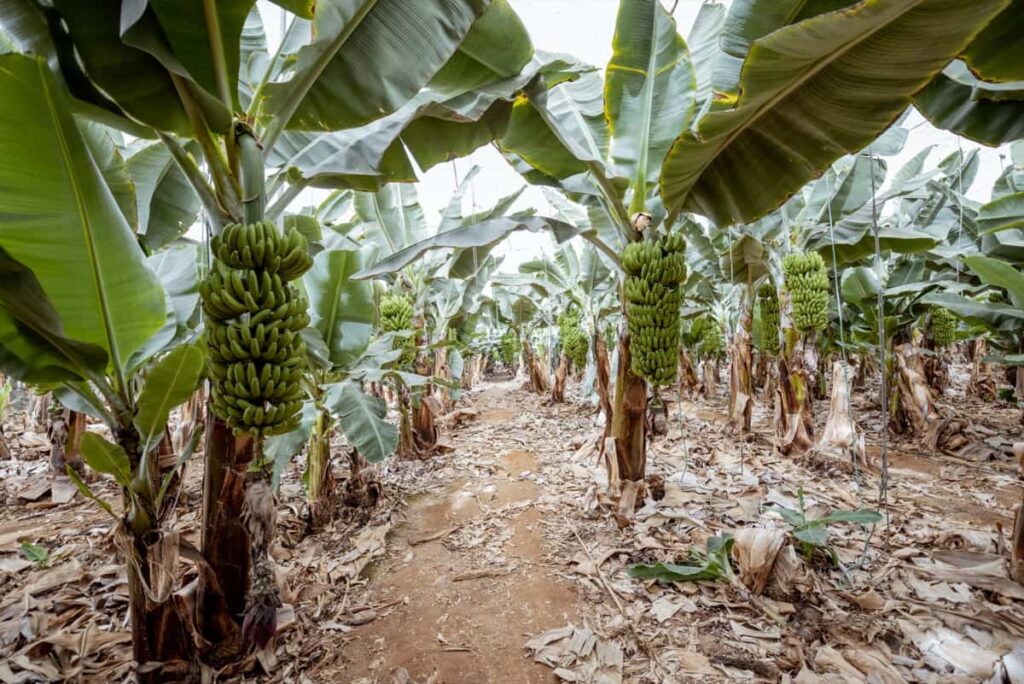
In this informative and engaging blog, we will take you on a journey through the twelve months of the year, providing you with essential tips and strategies tailored to each season. This banana orchard management guide and month-by-month maintenance guide will give you valuable insights into optimizing soil health, managing pests and diseases, implementing effective irrigation techniques, and maximizing yield.
What is Banana Farming and its Overview?
Musa plants produce long, edible bananas. Their curved shape, soft, starchy meat, and changeable rind vary in size, color, and firmness. The wild species Musa acuminata and Musa balbisiana produce most of our seedless bananas.
- Bananas are the largest herbaceous flowering plants that develop from a “corm.” Their “false stems” or pseudostems mimic trees. These plants grow rapidly in well-drained soils, 1.4 to 1.6 square meters daily.
- The pseudostem of banana leaves is the petiole and lamina. Banana plants grow from 3 to 7 meters tall with spirally arranged leaves up to 2.7 meters long and 60 centimeters wide. “Banana hearts” form on mature banana plants.
- Female flowers are near the leaves, while male blossoms are below. The banana heart produces “hands,” enormous dangling bunches of fruits. Bunches weigh 30–50 kg and have 3–20 levels. Banana “fingers” average 125 grams.
- Phloem bundles line banana peels. Cultivated types have few seeds and a three-carpel interior. The banana bloom tip is opposite the stem. The flower remains commonly mistaken for a seed or excretory vein.
Importance of Month-Wise Planning for Banana Orchard
Month-wise planning for banana orchard maintenance is of utmost importance for ensuring the optimal growth and productivity of the plants. Each month brings unique challenges and requirements for the orchard, including soil management, irrigation scheduling, pest and disease control, and pruning. By following a well-structured maintenance plan, farmers can address these tasks effectively, resulting in healthy banana plants and higher yields.
Best Tips for Banana Orchard Management
Suitable Climatic Conditions: Bananas thrive in warm, humid, and rainy climates. Temperatures between 10 to 40 degrees Celsius and relative humidity of 80% and above are ideal for banana growth. Dew, frost, arid conditions, and strong dry winds can adversely affect the plant’s growth, yield, and fruit quality.
In case you missed it: Growing Banana Organically in Maharashtra: Cultivation Practices and Production Management
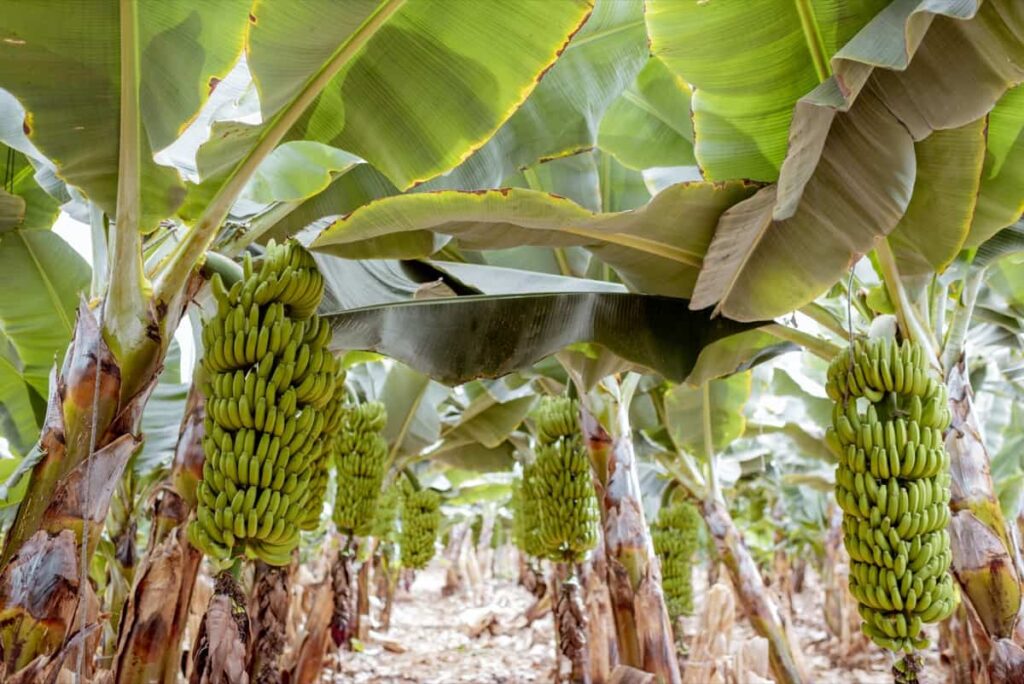
Soil Requirements: Banana plants are heavy feeders, so soil fertility is crucial. Opt for loamy soil with drainage, adequate fertility, moisture, and plenty of organic matter. The pH range of 6 to 8 is suitable. Avoid cultivating bananas in nutritionally deficient, saline, or very sandy soil.
Propagation Methods: Edible bananas cannot be grown from viable seeds, so suckers and sword suckers with narrow leaves are used for propagation. Banana plants have an underground stem called a rhizome that bears buds. Each bud sprouts and develops its pseudostem and rhizome, which can be used for propagation.
Plantation: Select healthy suckers and prepare them for planting by removing any decaying parts. The plantation can be done using either the Pit or Furrow methods. Planting can occur from February to May in South India and from July to August in North India. In South India, avoid planting during the summer months.
Spacing: For the Robusta, Nendran, Poovan, and Rasthali varieties, a spacing of 1.8 x 1.8 meters allows for 3,086 plants per hectare. Dwarf Cavendish requires a spacing of 1.5 x 1.5 meters, accommodating 4,444 plants per hectare.
Fertilizer and Manure: Bananas are fast-growing and short-lived plants, so providing them with adequate nutrients is essential. Generally, 20 kg of farmyard manure (FYM), 200g of nitrogen (N), 60g of phosphorus (P), and 300g of potassium (K) per banana plant are recommended. Nitrogen can be applied in three doses during the second, third, and fifth months, with adjustments based on location-specific requirements.
Intercropping: Intercropping with short-duration vegetables like beetroot, beans, cowpea, onion, or sunnhemp is recommended. Avoid intercropping with cucurbits.
Special Cultural Operations: regular maintenance tasks to ensure optimal growth and productivity of the banana orchard.
Mammutty digging: Conducting mammutty digging at bimonthly intervals helps loosen the soil around the plant, improving aeration and facilitating nutrient uptake.
Desuckering: Remove unwanted suckers near the base of the plant every month. This practice helps direct the plant’s energy toward fruit production and enhances overall plant health.
Mulching: Apply mulch using black polythene film or dried leaves. This helps in effective weed control, conserves moisture in the soil, and maintains a stable soil temperature.
Leaf removal: Regularly remove dried and diseased leaf from the plant to prevent the spread of leaf spot diseases. Burn the removed leaves to control the disease further.
Male flower removal: About a week after the last hand of bananas has opened, remove the male flowers. This practice helps redirect the plant’s resources toward fruit development and improves the quality of the bunches.
Floral remnant removal: In the Robusta banana variety, remove floral remnants about a week after the last hand has opened. This prevents the occurrence of fingertip disease.
Propping: Provide support to the plants during flowering by using bamboo or casuarina poles. Use single or double poles in a V shape and tie them to the bunches. This prevents the plants from bending or falling due to the weight of the fruits.
Peduncle cover: Cover the peduncle (the stalk that holds the bunch) with a flag leaf to protect the main stock end from rotting.
In case you missed it: Red Banana Farming in India: How to Start, Cultivation Practices, and Panting to Harvesting Guide
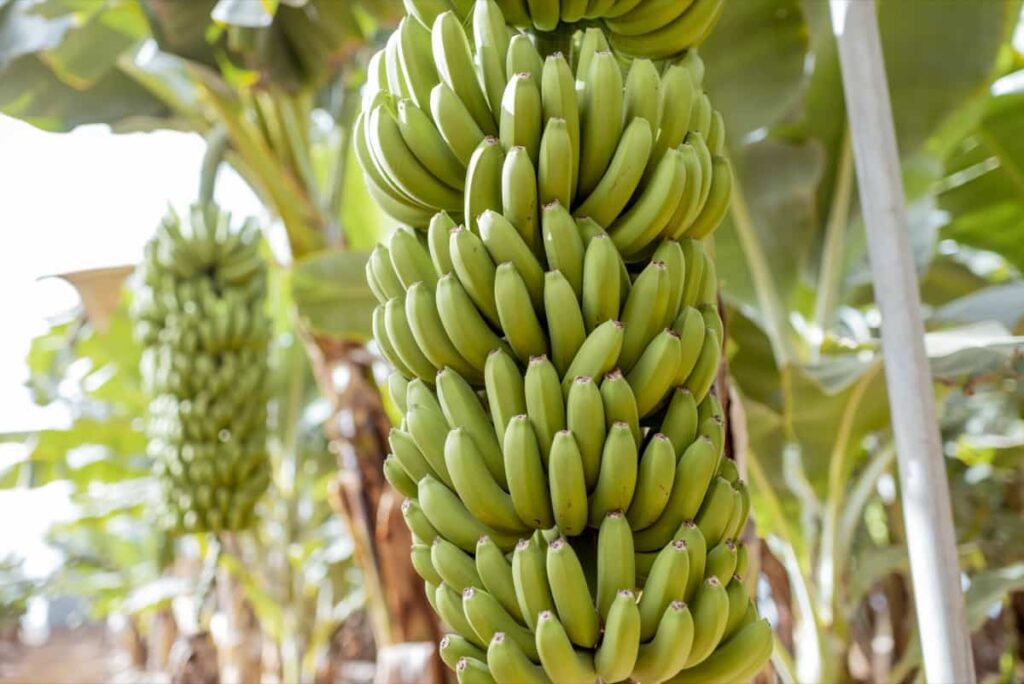
Growth regulator application: Spray growth regulator 2,4-D at 25 ppm (one gram in 40 liters of water for 200 bunches) on the bunches within 20 days after the last hand has opened in the Poovan banana variety. This practice improves the quality of the bunches and helps overcome seediness.
After Plantation Care: Support the plants through propping to protect them from falling during heavy winds. Remove unwanted suckers near the base of the plant through desuckering. Wrap or cover the bunch to protect the plants from excessive sun exposure, sunburn, hot wind, and dust. This can also improve fruit color.
Harvesting: Harvesting time depends on the variety. For dwarf varieties, harvesting is typically done after 12 to 15 months, while for tall varieties, it occurs after 15 to 18 months. Signs of maturity include plumpness of the fruit, filled angles, a slightly metallic sound when tapped, drying off of the top leaves, and a color change to light green or dark green.
Yield: The yield of bananas varies depending on the variety. Tall varieties yield approximately 15-25 tonnes per hectare, while dwarf varieties yield around 25-50 tonnes per hectare.
January Month Banana Orchard Maintenance Planning
- Desuckering: Remove unwanted suckers and retain one follower sucker for the ratoon crop if needed.
- Leaf removal: Regularly remove dried and diseased leaves to maintain plant health.
- Shooting: Monitor and manage the emergence of new shoots for proper growth.
- Bunch covering: Protect the bunches by covering them after the last hand is lifted.
- Anthracnose disease management: Watch for anthracnose disease on the fruits and spray at regular intervals.
- Thrips control: Watch for thrips and apply appropriate sprays to manage their presence.
February Month Banana Orchard Maintenance Planning
- Desuckering: Remove unwanted suckers to promote better growth and development of the main plant.
- Provide support (propping): Secure the plants with support structures, such as poles, to prevent damage from strong winds.
- Remove dried and diseased leaves: Regularly prune and discard any dried or diseased leaves to maintain plant health.
- Remove floral remnants: Trim away the remnants of wilted flowers to prevent the onset of diseases.
- Spraying of 2,4-D: Apply a 2,4-D solution to the bunches to enhance their quality and minimize seediness.
- Observe for thrips: Monitor for thrips infestation and take appropriate spraying measures if necessary.
- Spray for control of anthracnose disease: Apply suitable fungicides to prevent the spread of anthracnose, a common banana disease.
- Removal of male buds: Remove male flower buds to redirect the plant’s energy toward fruit development.
March Month Banana Orchard Maintenance Planning
- Thrips observation and spray: Monitor for thrips, a common pest that can damage banana plants. If detected, apply appropriate insecticides to control their population.
- Two sprays for anthracnose control: Implement two spray applications to combat anthracnose disease, a fungal infection that affects banana plants. This helps prevent the disease from spreading and damaging the crop.
In case you missed it: High Yield Hybrid Banana Varieties in India: State Wise Guide
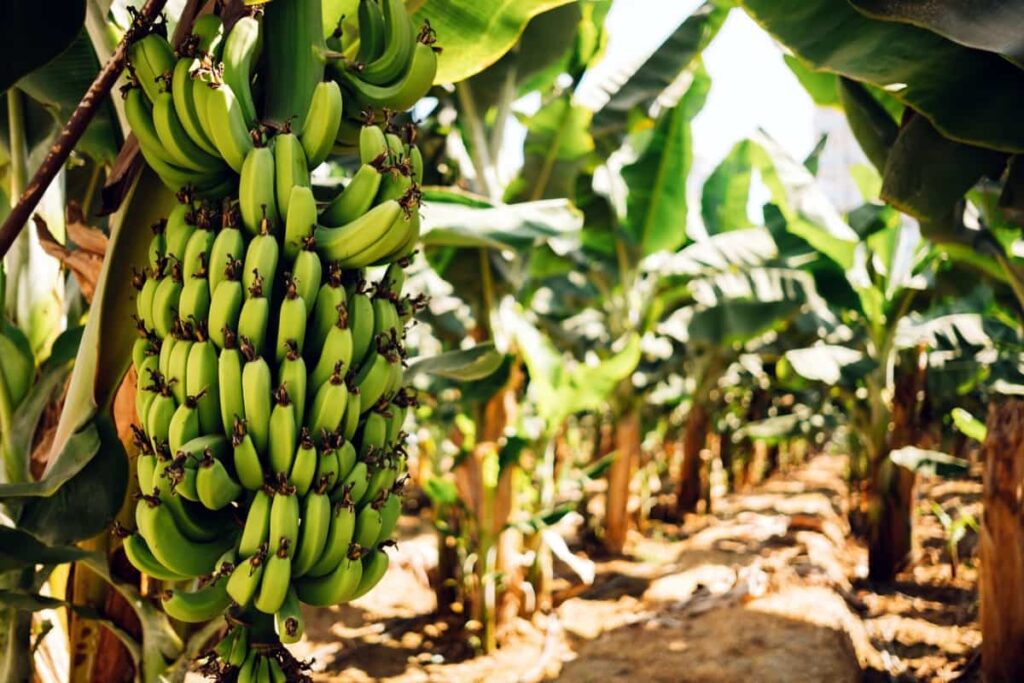
April Month Banana Orchard Maintenance Planning
- Thrips observation and spraying: Monitor for thrips infestation and apply appropriate insecticides for control.
- Two sprays for anthracnose disease: Conduct two sprays to combat anthracnose, a fungal disease that affects bananas.
- Harvesting: Remove dried and diseased leaves to maintain plant health.
- Shooting: Monitor and manage the emergence of new shoots from the plant.
- Bunch covering: Cover the bunches for protection after the last hand is lifted.
May Month Banana Orchard Maintenance Planning
- Prepare the land for planting.
- Prepare the suckers for transplantation.
- During the first month, plant the suckers and perform earthing up.
- Provide irrigation after four days to ensure proper moisture.
- Apply pre-emergent weedicides within a week to control weed growth.
- Use mulches to conserve moisture and suppress weed growth.
- Consider sowing intercrops to maximize land utilization.
- If nematode pretreatment was not done, apply 40 g of carbofuran per plant to control nematode infestation.
June Month Banana Orchard Maintenance Planning
Several tasks are essential during the second month of banana orchard maintenance planning. Mammutty digging should be conducted to loosen the soil and enhance nutrient uptake. If needed, gap filling of suckers can be performed to ensure optimal plant density. Additionally, corm injection is recommended to control Panama wilt, a devastating disease affecting banana plants. These activities contribute to the overall health and productivity of the orchard during June.
July Month Banana Orchard Maintenance Planning
- Apply the first dose of Nitrogen, Potassium, and Phosphorus to provide essential nutrients to the plants.
- Conduct desuckering by removing unwanted suckers near the base of the plants.
- Regularly remove dried and diseased leaves to prevent the spread of diseases.
- Perform stem injection to control aphids and the bunchy top virus.
- Keep a close eye on the development of the Sigatoka leaf spot and apply appropriate sprays if necessary.
- Implement control measures to combat the Panama wilt and cucumber mosaic virus.
- Harvest the intercrop that was planted alongside the banana plants.
- Consider incorporating the sun hemp crop into the soil on the 45th day or at the flowering stage.
August Month Banana Orchard Maintenance Planning
- Mammutty digging: Perform regular soil loosening to improve aeration and nutrient uptake.
- Desuckering: Remove unwanted suckers to promote better fruit production.
- Leaf removal: Eliminate dried and diseased leaves to prevent the spread of diseases.
- Sigatoka leaf spot: Monitor for this common banana disease and apply appropriate sprays if necessary.
- Panama wilt and cucumber mosaic virus: Implement control measures to prevent these diseases from affecting the banana plants.
- Harvesting of intercrop: Harvest any intercropped vegetables or crops planted alongside the bananas.
September Month Banana Orchard Maintenance Planning
- Desuckering: Remove unwanted suckers to redirect plant energy toward fruit production.
- Leaf maintenance: Remove dried and diseased leaves to prevent disease spread.
- Fertilizer application: Apply the second dose of Nitrogen and Potassium fertilizers, along with biofertilizers, to support plant growth.
- Pest control: Monitor for stem weevil and apply appropriate sprays or injections for control.
- Virus control: Conduct stem injections to control aphids and prevent the spread of bunchy top viruses.
- Disease management: Watch for Sigatoka leaf spot and apply necessary sprays to control its occurrence.
- Virus prevention: Implement control measures to prevent cucumber mosaic virus in the orchard.
In case you missed it: Optimizing Oil Palm Orchard Management with Month-wise Operations for High Yield and Profit
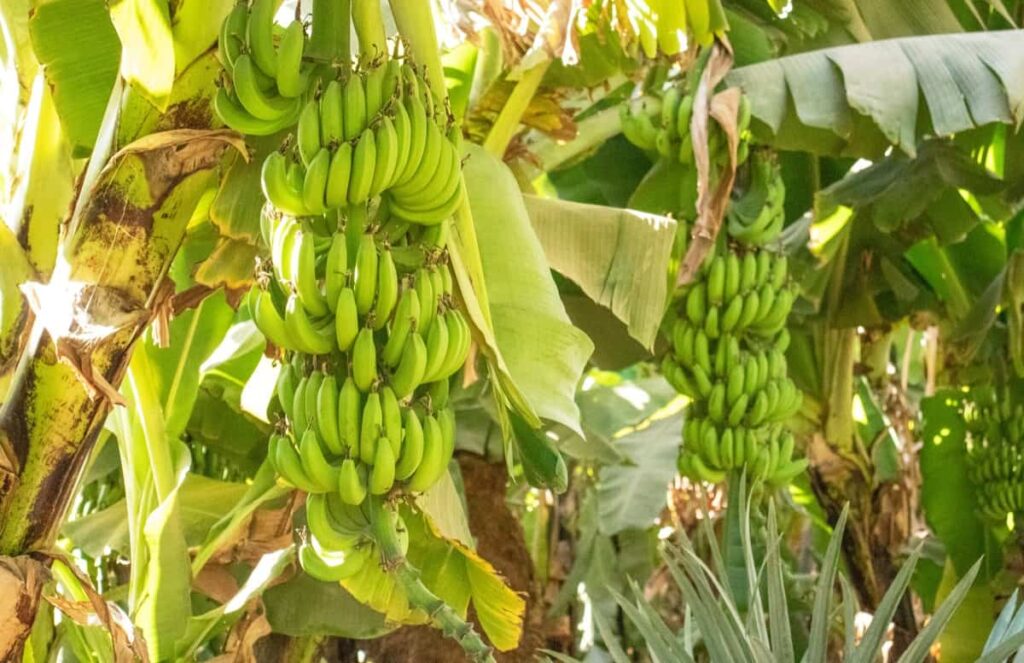
October Month Banana Orchard Maintenance Planning
- Desuckering: Eliminate unwanted suckers near the base of banana plants to redirect energy for fruit production.
- Leaf removal: Regularly clear away dried and diseased leaves to prevent disease spread and ensure plant health.
- Mummutty digging: Loosen the soil around plants to enhance air circulation and nutrient absorption.
- Stem weevil control: Apply appropriate insecticides to combat stem weevil infestations.
- Panama wilt management: Implement control measures to prevent the spread of Panama wilt, a destructive disease affecting bananas.
November Month Banana Orchard Maintenance Planning
- Desuckering: Remove unwanted suckers near the base of the banana plants to promote better fruit development.
- Leaf removal: Regularly eliminate dried and diseased leaves to prevent the spread of diseases and maintain plant vitality.
- Application of 3rd dose of Nitrogen and Potassium fertilizers: Provide the necessary nutrients to support healthy growth and fruit production.
- Spraying or injection for stem weevil control: Apply appropriate insecticides through spraying or injection methods to combat stem weevil infestations.
- Stem injection for aphid and bunchy top virus control: Implement stem injection techniques to manage aphids and prevent the spread of the bunchy top virus.
December Month Banana Orchard Maintenance Planning
- Desuckering: Remove unwanted suckers to promote healthy growth and optimize fruit production.
- Leaf removal: Regularly eliminate dried and diseased leaves to spread infections and maintain overall plant health.
- Stem weevil control: Apply appropriate insecticides to combat the damaging effects of stem weevils on banana plants.
In case you missed it: Almond Orchard Management: Month-by-Month Maintenance Guide for Maximum Yield
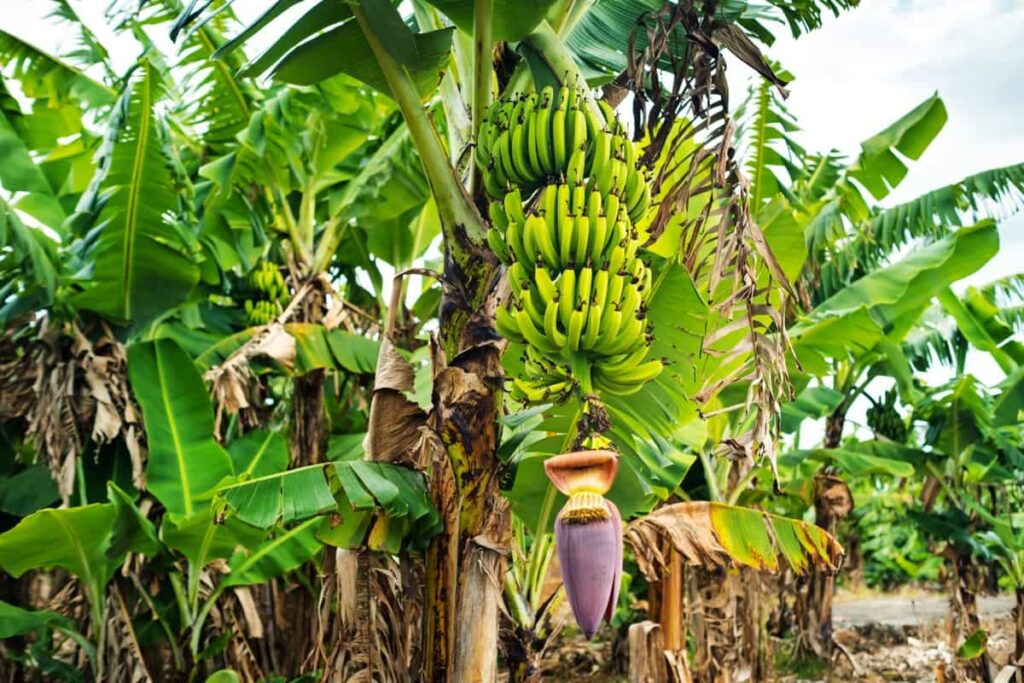
Conclusion
Maintaining a thriving banana orchard requires year-round attention. By following a month-by-month maintenance guide and implementing appropriate practices for each season, growers can maximize their chances of success and enjoy a healthy and productive banana harvest.
- Sheep Farming Business Plan for Beginners
- Aquaponic Farming at Home: A Step-By-Step Guide
- Profitable Village Farming Business Ideas in 2024
- High-Yield Aquaculture: Fast-Growing Fish for Farming
- Effective Fish Pond Construction Techniques for Beginners
- Irrigation and Water Management in Pineapple Farming
- Blossom to Harvest: Mastering Flowering and Pollination in Papaya Farming
- Pig Fattening Essentials: From Selection to Sale for Beginners
- Raising Wagyu Cattle: A Complete Guide for Premium Beef Production
- Soil Types and Their Water Holding Capacity
- Optimizing Irrigation Schedules for Coconut Groves for Enhanced Yield
- Espresso Your Garden: Coffee Grounds for Healthier Acid-Loving Plants
- The Best Soil Mix for Snake Plants: How to Mix Your Own Snake Plant Soil
- Green Thumb Success: Expert Tips for Cultivating Greenhouse Beans All Year Round
- Bloom All Year Round: The Ultimate Guide to Indoor Hyacinth Care
- Eco-Friendly Gardening: How to Make Liquid Fertilizer from Kitchen Waste
- Ultimate Guide to Grow Anise in Pots: Explore Seed Propagation to Harvesting
- Guide to Raising Chester White Pigs: Discover Breed Facts to Growth Management
- Mastering the Elegance: The Ultimate Guide to Weeping Cherry Tree Care, Planting, and Maintenance
- Ultimate Guide to Planting Garlic in Grow Bags: Growing Strategies for Beginners
- How to Fix Spider Plant Leaf-Related Problems: Natural and Organic Remedies
- 10 Reasons Why Your Tulsi Plant is Shedding Leaves: Home Remedies and Solutions
- Optimizing Growth and Yield: The Advantages of Palm Bunch Ash Fertilizer
- Utilizing Neem Oil Extract as a Natural Pesticide for Hydrangea
- From Soil to Harvest: Various Ways in Which Farmers Can Use AI Tools
- Steps to Encourage and Induce Citrus Flowers: A Comprehensive Guide
- How to Fix Snake Plant Leaf-Related Issues: Natural and Organic Remedies
- Transform Your Garden into a Fragrant Oasis with Raat Ki Rani (Night Blooming Jasmine)
- Discover the Ideal Chicken Breeds for Philippine Farms
- How to Create a Poultry Egg Farm Business Plan for Profits
- Grow Lemon Cucumbers Like a Pro: Insider Techniques for Bountiful Yields
- Ultimate Guide to Caring for Your Pink Princess Philodendron: Tips for Thriving Variegation
- Areca Nut Profit Per Acre: Calculating Yield and Cost of Cultivation
- How Kaveri Chicken is Becoming a More Profitable Breed in Indian Backyards
- Transform Your Barn: 9 Steps to Convert a Horse Stall into a Chicken Coop
- Exploring Suffolk Sheep Disadvantages with Limitations and Challenges
